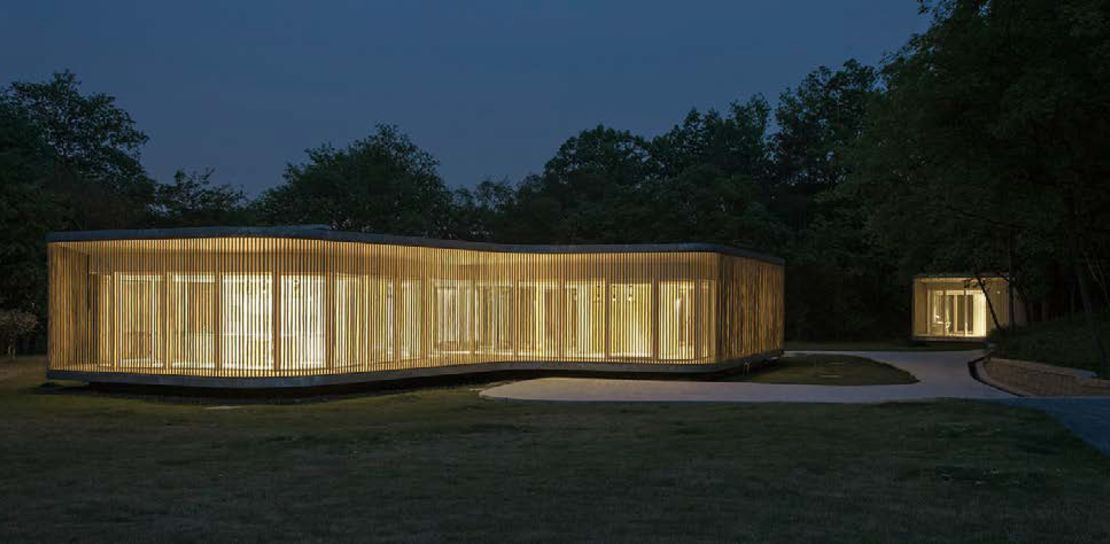Editor’s Note: CNN Travel’s series often carries sponsorship originating from the countries and regions we profile. However, CNN retains full editorial control over all of its reports. Read the policy.
Story highlights
Big name architects given free rein by Chinese businessman to build what they like
Park opened in 2013 with stunning Steven Holl designed futuristic centerpiece
Nominated as Leading Culture Destination in 2015, the museum world's Oscars
In 2003, nearly two dozen of the biggest names in international and Chinese architecture were invited to this bamboo-clad patch of mountain on the outskirts of the ancient Chinese capital of Nanjing.
Their ranks included New York architect Steven Holl, dissident artist Ai Weiwei, Chinese Pritzker prize winner Wang Shu and the UK-based David Adjaye and each drew lots for a rare commission:
The opportunity to design one of 20 buildings within the unique landscape largely free from any pesky client constraints.
The project, now known as the Sifang Art Collective, was conceived and bankrolled by a successful local businessman, Lu Jun, and his art collector son Lu Xun.
Alarmed at the way developers were changing the face of Chinese cities by building cheap and repetitive architecture, they wanted to “break the mold” of China’s rush to urbanize and allow people to experience the very best of contemporary architecture, design and art.
PHOTOS: City of Emperors: Why Nanjing’s beauty still resonates
Playful and intimate
It’s hard not to be impressed by the results.
The park’s jaw dropping futuristic centerpiece – a suspended gallery by Holl that displays the family’s fine art collection – grabs your attention as you reach the gate at the crest of a hill.
The russet-roofed Conference Center designed by Japanese architect Arata Isozaki is a meeting venue that can hold 400 people.
It sits next to Hotel Monochrome, a small hotel built as a modernist take on a Chinese village by Chinese architect Liu Jiakun.
Dotted around the green 115-acre site are 17 other houses and villas.
They’re all fiercely modern yet at ease in the natural landscape, which in late September is just beginning to show autumnal hues.
Many have delightful and intimate touches.
On the rooftop of the villa designed by Chilean architect Mathias Klotz is a playful lily pond with concrete “pads” that act as stepping stones guiding visitors to a hidden spiral stairwell that takes them down into the house.
Wang Shu puts his spin on a Chinese courtyard house. The three-sided building incorporates two ancient trees – one in the courtyard and one in the building itself.
And the entry to Adjaye’s sun-dappled Light Box is a tunnel formed of densely packed bamboo.
READ: China’s private art museums: Icons or vanity projects?
‘Crazy architects’

Such a bold project in any country would likely have its fair share of setbacks.
In China, where private museums are relatively new and don’t qualify for government support or subsidy, the challenges were acute.
The art museum opened to the public in 2013. According to a Wall Street Journal report the same year, at least $164 million has been invested.
“They invited architects to do what they liked and architects can be crazy and want to do things regardless of cost,” said Zhou Qi, a Nanjing-based architect who designed the People’s Daily Headquarters in Beijing.
Five of the planned buildings remain unfinished.
Zhou says it the results achieved so far are “not bad at all” even if the process getting there has been “painful.”
Lu and his son declined an interview request.
READ: Surprises as museum ‘Oscars’ shortlist revealed
Architecture catnip
Despite the growing pains, the park was shortlisted as a Leading Culture Destination for 2015.
The prestigious awards – dubbed the “Oscars for museums” – honor the world’s most visionary art institutions and emerging cultural hotspots.
Entrance to the park and art museum, which has rotating exhibitions, a shop and cafe, costs 50 yuan ($7.80) per person and each month they receive around 2,000 visitors. Private tours of inside the completed buildings cost extra and need to be booked in advance.
The park is catnip for architecture students from local universities but doesn’t feature among the tourist brochures in the city’s upmarket hotels.
It took me three tries to find a taxi driver familiar with the location. He happened to live in a village down the road but was unaware the park existed.
READ: Abandoned architectural marvels in China’s largest ghost town
Dream homes
A stylish low-rise luxury apartment complex was completed on the site in 2015, along with a recreation center designed by Italian architect Ettore Sottsass.
More residential housing is planned, suggesting that the long-term strategy may be to turn the park into a retreat for art loving second homers rather than a major stopping point on China’s tourist trail.
While Nanjing doesn’t hold the same cultural sway as traditional tourist capitals Shanghai or Beijing, the city’s Sifang Art Park is a fascinating place to take in some stunning architecture in an unexpected corner of China – and gives a tantalizing glimpse into the kind of dream homes the world’s top architects might build for themselves.
READ: Chinese bookworms ‘pay if they want’ in Nanjing
Sifang Art Museum, 9 Zhenqi Road, Pukou District, Nanjing, Jiangsu, China
CNN’s Shen Lu contributed to this report.














